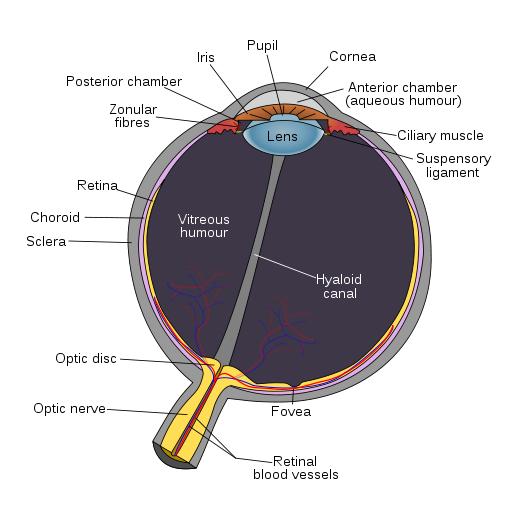Eyesight

Sight is one of the five senses that help us to get information about what is going on in the world around us. We see through our eyes, which are organs that take in light and images and turn them into electrical impulses that our brain can understand.
How do we see? When we see something, what we are seeing is actually reflected light. Light rays bounce off of objects and into our eyes.
Fun facts about the eye The image at the retina is actually upside down from the actual image. Our brain figures this out for us and switches it around, or we would get really confused! The cornea is a clear layer at the front of the eye that helps protect it. We have a blind spot where the optical nerve connects to the retina. Tears help keep the eye clean, but scientist don't really understand why we cry when we are sad or upset. The average person blinks 15 times per minute. Around eight percent of men are color blind, but less than one percent of women.
.
organs
• Protective equipment (eyelids, eyelashes)
• Tendon syndrome (light tear and drainage device)
• muscles
• Eyeball
• Optic nerve Szemideg és látópálya
• Visual cortex

Our Amazing Eyeballs Pupil and Iris: Eyes are amazing and complex organs. In order for us to see, light enters our eyes through the black spot in the middle which is really a hole in the eye called the pupil.
The pupil can change sizes with the help of the colored part around it, a muscle called the iris. By opening and closing the pupil, the iris can control the amount of light that enters the eye. If the light is too bright, the pupil will shrink to let in less light and protect the eye. If it's dark, the iris will open the pupil up so more light can get into the eye.
Retina: Once the light is in our eye it passes through fluids and lands on the retina at the back of the eye. The retina turns the light rays into signals that our brain can understand.
The retina uses light sensitive cells called rods and cones to see. The rods are extra sensitive to light and help us to see when it's dark. The cones help us to see color. There are three types of cones each helping us to see a different color of light: red, green, and blue.
Focus: In order for the light to be focused on the retina, our eyes have a lens. The brain sends feedback signals to the muscles around the lens to tell it how to focus the light. Just like the way a camera or microscope works, when we adjust the lens we can bring the image into focus. When the lens and muscles can't quite focus the light just right, we end up needing glasses or contacts to help our eyes out.
Off to the Brain: The rods and cones of the retina change light into electrical signals for our brain.
The visual cortex of the brain is a part of the cerebral cortex that plays an important role in processing visual information. It is located in the occipital lobe in the back of the skull.
The optic nerve takes these signals to the brain. The brain also helps to control the eye to help it focus and to control where you are looking. Both eyes move together with speed and precision to allow us to see with the help of the brain. The optic nerve transmits all visual information including brightness perception, color perception and contrast (visual acuity). It also conducts the visual impulses that are responsible for two important neurological reflexes: the light reflex and the accommodation reflex. The light reflex refers to the constriction of both pupils that occurs when light is shone into either eye; the accommodation reflex refers to the swelling of the lens of eye that occurs when one looks at a near object as in reading (lens adjusts to near vision)
Why two eyeballs? With two eyeballs our brain gets two slightly different pictures from different angles. Although we only "see" one image, the brain uses these two images to give us information on how far away something is. This is called depth perception.
Diseases
Near-sightedness, also known as short-sightedness and myopia, is a condition of the eye where light focuses in front of, instead of on, the retina
Far-sightedness, also known as long-sightedness and hyperopia, is a condition of the eye in which light is focused behind, instead of on, the retina
Visual impairment, also known as vision impairment or vision loss, is a decreased ability to see to a degree that causes problems not fixable by usual means, such as glasses.Some also include those who have a decreased ability to see because they do not have access to glasses or contact lenses. Visual impairment is often defined as a best corrected visual acuity of worse than either 20/40 or 20/60.The term blindness is used for complete or nearly complete vision loss.[4] Visual impairment may cause people difficulties with normal daily activities such as driving, reading, socializing, and walking
Glaukoma
www.youtube.com/watch?v=0FywFsT0R58
www.youtube.com/watch?v=-IWk5NkxQF8
